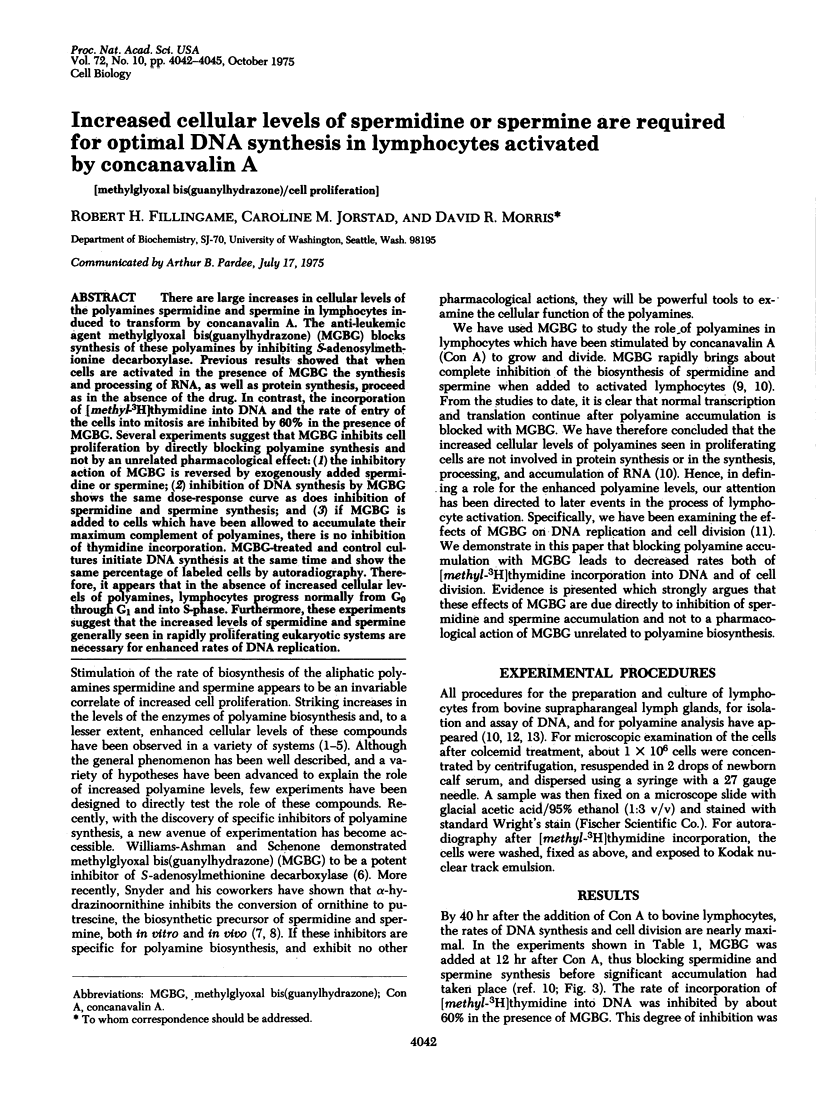Abstract
There are large increases in cellular levels of the polyamines spermidine and spermine in lymphocytes induced to transform by concanavalin A. The anti-leukemic agent methylglyoxal bis(guanylhydrazone) (MGBG) blocks synthesis of these polyamines by inhibiting S-adenosylmethionine decarboxylase. Previous results showed that when cells are activated in the presence of MGBG the synthesis and processing of RNA, as well as protein synthesis, proceed as in the absence of the drug. In contrast, the incorporation of [methyl-3H]thymidine into DNA and the rate of entry of the cells into mitosis are inhibited by 60% in the presence of MGBG. Several experiments suggest that MGBG inhibits cell proliferation by directly blocking polyamine synthesis and not by an unrelated pharmacological effect: (1) the inhibitory action of MGBG is reversed by exogenously added spermidine or spermine; (2) inhibition of DNA synthesis by MGBG shows the same dose-response curve as does inhibition of spermidine and spermine synthesis; and (3) if MGBG is added to cells which have been allowed to accumulate their maximum complement of polyamines, there is no inhibition of thymidine incorporation. MGBG-treated and control cultures initiate DNA synthesis at the same time and show the same percentage of labeled cells by autoradiography. Therefore, it appears that in the absence of increased cellular levels of polyamines, lymphocytes progress normally from G0 through G1 and into S-phase. Furthermore, these experiments suggest that the increased levels of spermidine and spermine generally seen in rapidly proliferating eukaryotic systems are necessary for enhanced rates of DNA replication.
Full text
PDF



Selected References
These references are in PubMed. This may not be the complete list of references from this article.
- ALARCON R. A., FOLEY G. E., MODEST E. J. Effects of spermine on mammalian cells. Arch Biochem Biophys. 1961 Sep;94:540–541. doi: 10.1016/0003-9861(61)90083-2. [DOI] [PubMed] [Google Scholar]
- BLASCHKO H. The amine oxidases of mammalian blood plasma. Adv Comp Physiol Biochem. 1962;1:67–116. [PubMed] [Google Scholar]
- Dion A. S., Cohen S. S. Polyamines in the synthesis of bacteriophage deoxyribonucleic acid. II. Requirement for polyamines in T4 infection of a polyamine auxotroph. J Virol. 1972 Mar;9(3):423–430. doi: 10.1128/jvi.9.3.423-430.1972. [DOI] [PMC free article] [PubMed] [Google Scholar]
- Fillingame R. H., Morris D. R. Polyamine accumulation during lymphocyte transformation and its relation to the synthesis, processing, and accumulation of ribonucleic acid. Biochemistry. 1973 Oct 23;12(22):4479–4487. doi: 10.1021/bi00746a028. [DOI] [PubMed] [Google Scholar]
- HIRSCH J. G. Spermine oxidase: an amine oxidase with specificity for spermine and spermidine. J Exp Med. 1953 Mar;97(3):345–355. doi: 10.1084/jem.97.3.345. [DOI] [PMC free article] [PubMed] [Google Scholar]
- Harik S. I., Hollenberg M. D., Snyder S. H. Alpha-hydrazino-ornithine blocks net synthesis of putrescine but not of RNA and DNA. Nature. 1974 May 17;249(454):250–251. doi: 10.1038/249250a0. [DOI] [PubMed] [Google Scholar]
- Harik S. I., Snyder S. H. Ornithine decarboxylase: inhibition by alpha-hydrazinoornithine. Biochim Biophys Acta. 1973 Dec 19;327(2):501–509. doi: 10.1016/0005-2744(73)90433-6. [DOI] [PubMed] [Google Scholar]
- Higgins M. L., Tillman M. C., Rupp J. P., Leach F. R. The effect of polyamines on cell culture cells. J Cell Physiol. 1969 Oct;74(2):149–154. doi: 10.1002/jcp.1040740206. [DOI] [PubMed] [Google Scholar]
- Morris D. R., Fillingame R. H. Regulation of amino acid decarboxylation. Annu Rev Biochem. 1974;43(0):303–325. doi: 10.1146/annurev.bi.43.070174.001511. [DOI] [PubMed] [Google Scholar]
- Morris D. R., Jorstad C. M. Growth and macromolecular composition of a mutant of Escherichia coli during polyamine limitation. J Bacteriol. 1973 Jan;113(1):271–277. doi: 10.1128/jb.113.1.271-277.1973. [DOI] [PMC free article] [PubMed] [Google Scholar]
- Morris D. R., Koffron K. L., Okstein C. J. An automated method for polyamine analysis. Anal Biochem. 1969 Sep;30(3):449–453. doi: 10.1016/0003-2697(69)90140-7. [DOI] [PubMed] [Google Scholar]
- Otani S., Mizoguchi Y., Matsui I., Morisawa S. Inhibition of DNA synthesis by methylglyoxal bis(guanylhydrazone) during lymphocyte transformation. Mol Biol Rep. 1974 Dec;1(8):431–436. doi: 10.1007/BF00360667. [DOI] [PubMed] [Google Scholar]
- Schekman R., Weiner A., Kornberg A. Multienzyme systems of DNA replication. Science. 1974 Dec 13;186(4168):987–993. doi: 10.1126/science.186.4168.987. [DOI] [PubMed] [Google Scholar]
- Tabor H., Tabor C. W. Biosynthesis and metabolism of 1,4-diaminobutane, spermidine, spermine, and related amines. Adv Enzymol Relat Areas Mol Biol. 1972;36:203–268. doi: 10.1002/9780470122815.ch7. [DOI] [PubMed] [Google Scholar]
- Williams-Ashman H. G., Schenone A. Methyl glyoxal bis(guanylhydrazone) as a potent inhibitor of mammalian and yeast S-adenosylmethionine decarboxylases. Biochem Biophys Res Commun. 1972 Jan 14;46(1):288–295. doi: 10.1016/0006-291x(72)90661-4. [DOI] [PubMed] [Google Scholar]


